Page Links:
Home Page
About Page
What's New Page
Ships Featured
On This Site
2012 Menominee
& Marinette Ships
2011 Menominee
& Marinette Ships
Reserve
Conversion
Older Menominee
& Marinette Ships
2000 - 2010
The Ships Of
Marinette Marine
Menominee North
Pier Lighthouse
Menominee &
Marinette Parks
& Things
Interstate
Bridge Project
Soo Locks
Galleries
(22 Different)
Waterfalls Page (new)
General Photo
Gallery
Odds 'n' Ends
Wagenborg Ships
Ship Photos
From Green Bay
Escanaba Ore &
More
Sturgeon Bay
Lay-Ups
A Tour Of
Sturgeon Bay
Edward L Ryerson
1000-Footers
Favorite Photos
Misc. Great Lakes
Ships
Guest Book Page
Favorite Links
Page
|
People in Menominee and Marinette have seen a lot of the windmill parts being unloaded at KK Integrated Logistics over the past 4 months beginning on Aug. 5, 2007 with the arrival of a load of windmill blades aboard the Vanessa C. This page will show how all of the major pieces fit together to make a complete windmill (obviously there are also many other smaller parts involved in the process that are not shown).
Image to the right: - - ->
A windmill is about to be completed with the addition of the rotor assembly.
Thanks to Steve Hinkley of Fond du Lac, WI for this photo and the final two in the series of six photos below, and for helping me out with the correct terminology in defining the parts of a windmill (wind turbine)!
This page also contains two other sections - The first has photos from "Engineer's Day" festivities on June 25, 2010 of 16 placards depicting the work done (new cofferdams in the Sabin Lock Approach) on the new Soo Lock at Sault Ste. Marie. These two locks (the Davis Lock is the other) are scheduled for demolition (sometime in the future) to make way for a new "Poe-size" Lock. The Poe Lock is the only lock large enough to handle almost 75% of the U.S. Great Lakes ships; including the massive 1000-footers. The second section will take you aboard the Valley Camp Museum Ship at Sault Ste. Marie, MI. Currently, there are 73 photos of different areas of the ship, including the engine room, pilothouse, and more; and some of the many exhibits aboard the ship, including the remains of the two lifeboats recovered from the ill-fated Edmund Fitzgerald, ship models, and other exhibits.
Click Here to go to the placards depicting work on the New Soo Lock
Click Here to go to the Valley Camp Museum Ship exhibits
|
 |
|
Click on a photo below to see a larger version - (Click your Browser's "Back" button to return here)
|
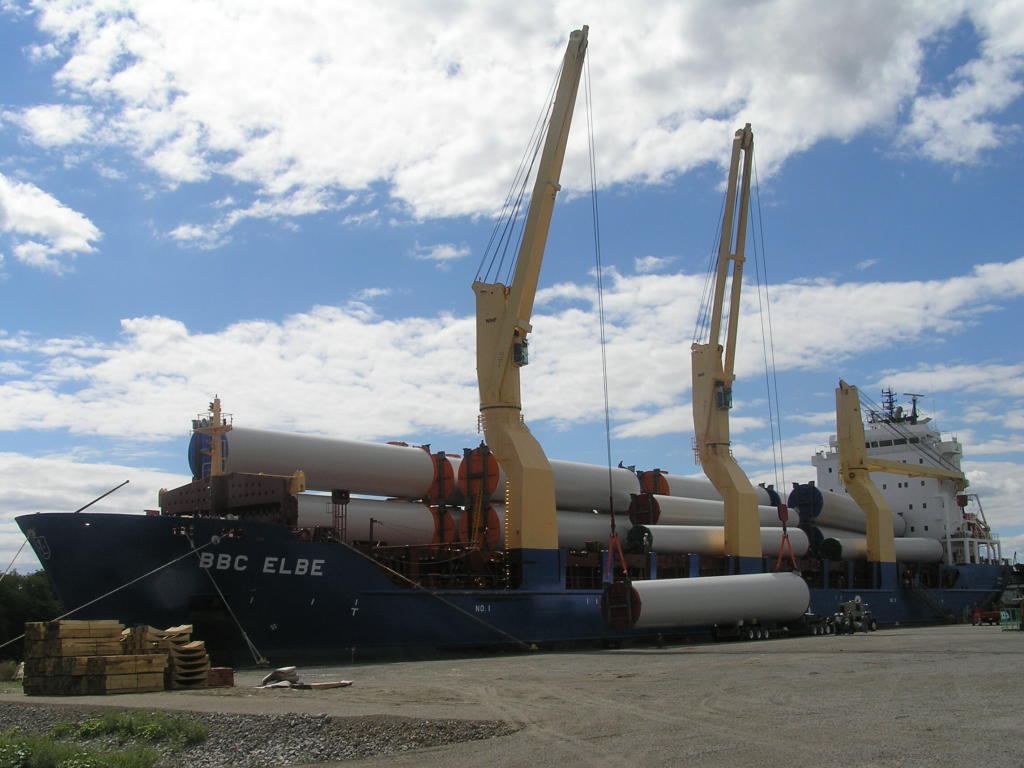 | Windmill Bases - It takes three of these to make one complete (about 315-ft. tall) windmill tower |
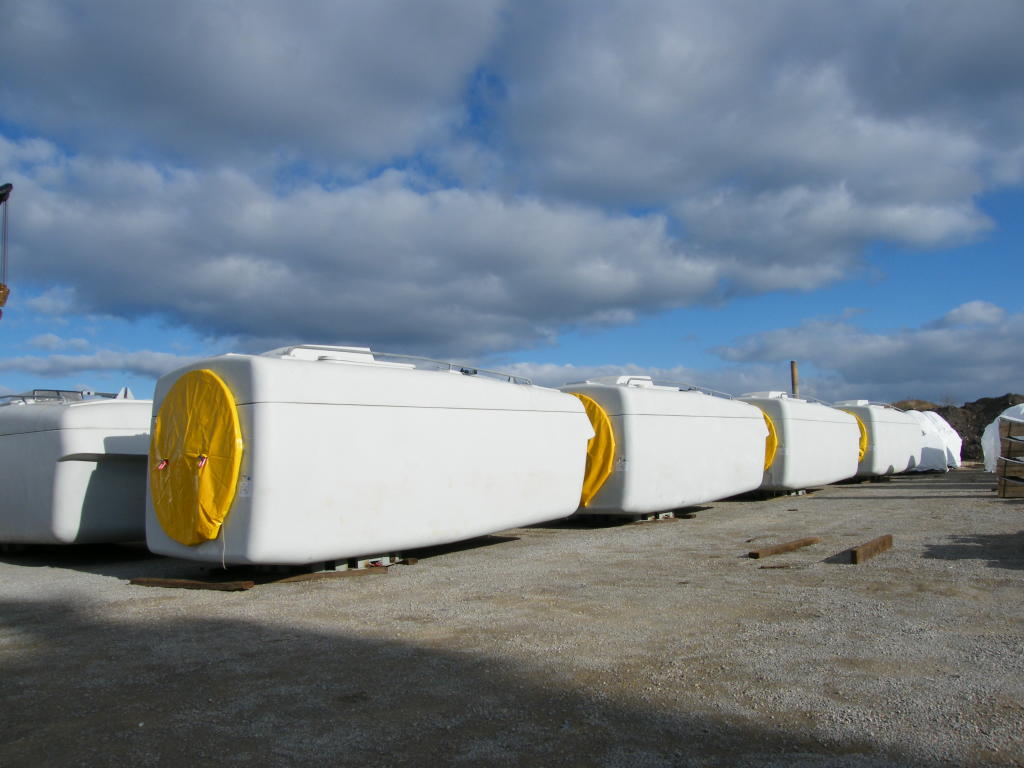 | Windmill Nacelle - This piece fits atop the three-piece tower and houses the gear box, drive train, generator, and other components of a wind turbine |
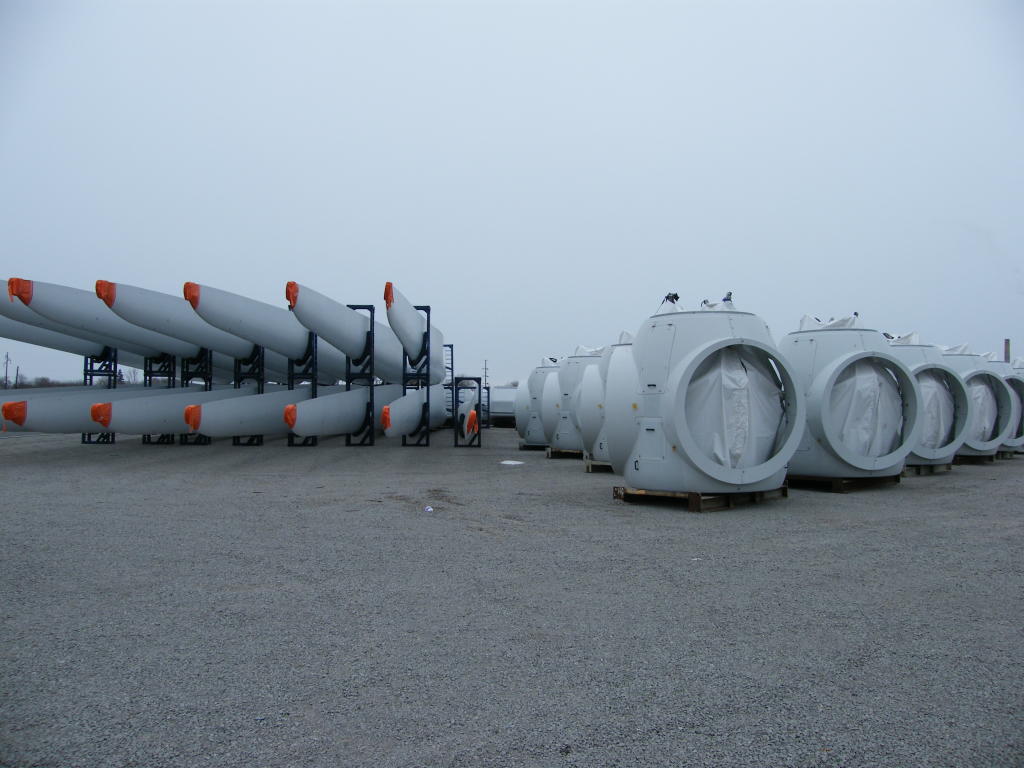 | Windmill Blades & Rotors - Three blades fit into the rotor, which then fits onto the Nacelle |
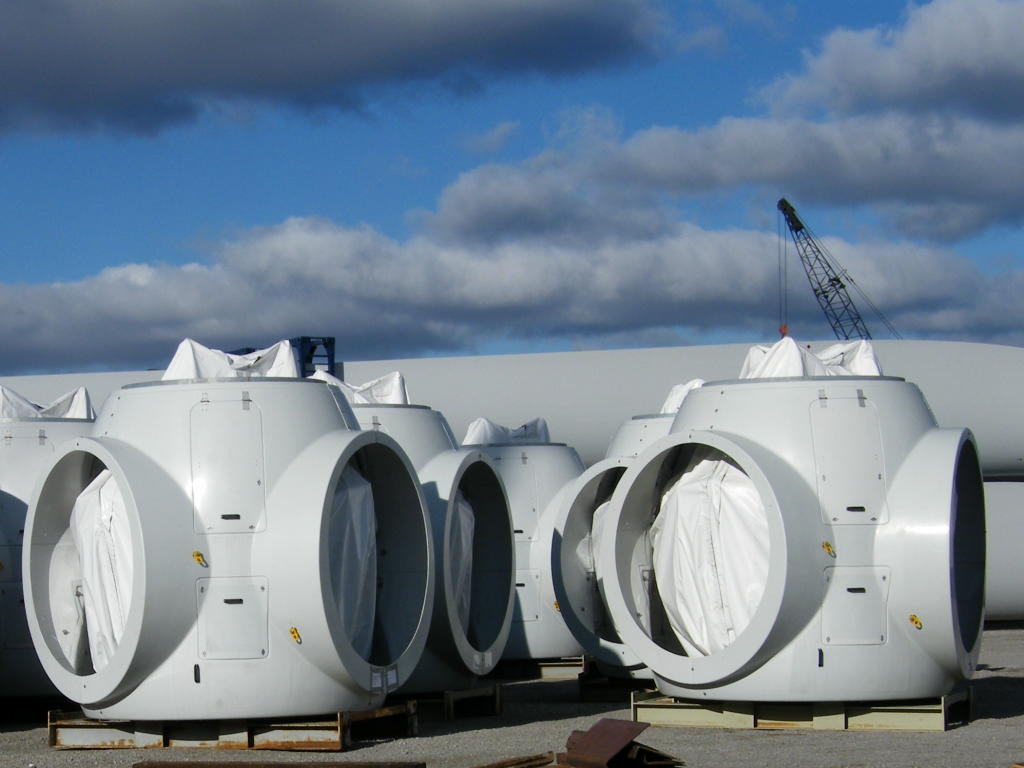 | Windmill Rotors - A closer look at the rotors |
 | Windmill Blades - Each windmill blade is 120-ft. long and is shipped in a bundle with two blades per bundle |
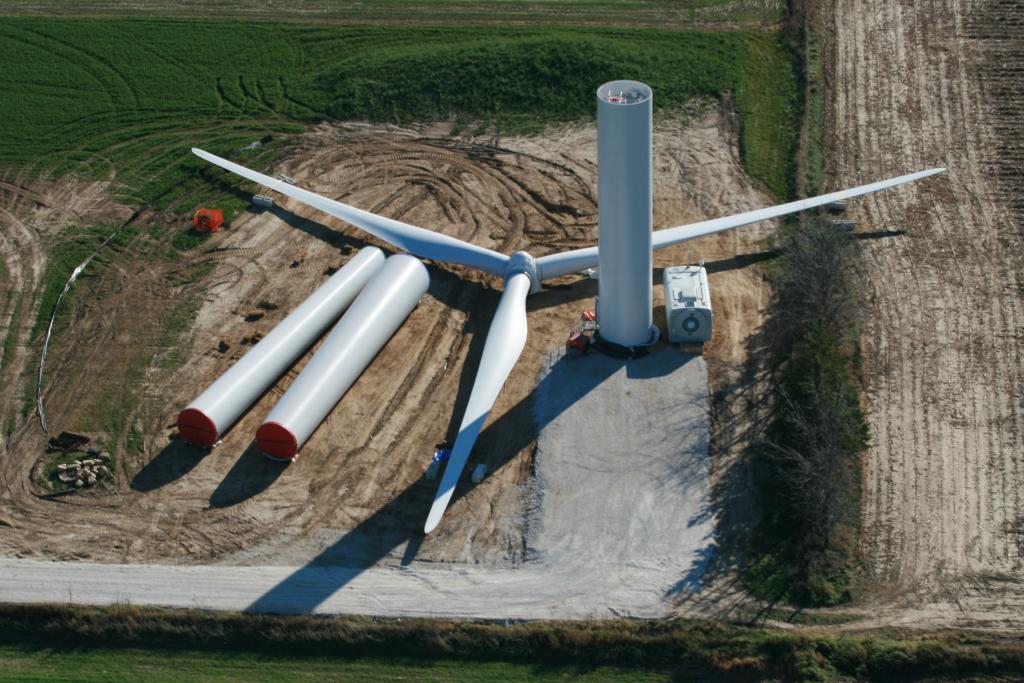 | Windmill - A look at a windmill in pieces: The base of the windmill tower is in place, two more will fit on top of that, the nacelle then fits on top of the tower, and finally the rotor (windmill blade) assembly attaches to the nacelle.
(Photo: Steve Hinkley) |
 | Windmill - The rotor assembly is about to be fitted to the nacelle atop the tower to complete one windmill (technically - wind turbine).
(Photo: Steve Hinkley) |
|
|
Soo Trip June 2010 Special Galleries
Engineer's Day Exhibits
On Engineer's Day, June 25, 2010, the Marine Post Office (between the Poe Lock and Davis Lock) held an exhibit with placards depicting work already completed in preparation for the building of a New Soo Lock in the area occupied by the present Davis Lock and Sabin Lock. Each of the 16 placards placed around the inside of the building explained what was happening and contained 3 photos with descriptions of the work being done in the photos. I photographed each placard as best I could (there were a LOT of people viewing the exhibits), and then cropped each photo contained within the placard in an attempt to make them easier to see and read. So, there are four photos per placard (except the 16th one which only had two photos) - The first photo in each sequence will show the entire placard, the other three photos will be the cropped individual photos. Some of the cropped photos aren't the best; but should give you a good idea of what is going on in each one. I hope you enjoy this special photo gallery!
Placard #1
Photo #1
Photo #2
Photo #3
Placard #2
Photo #1
Photo #2
Photo #3
Placard #3
Photo #1
Photo #2
Photo #3
Placard #4
Photo #1
Photo #2
Photo #3
Placard #5
Photo #1
Photo #2
Photo #3
Placard #6
Photo #1
Photo #2
Photo #3
Placard #7
Photo #1
Photo #2
Photo #3
Placard #8
Photo #1
Photo #2
Photo #3
Placard #9
Photo #1
Photo #2
Photo #3
Placard #10
Photo #1
Photo #2
Photo #3
Placard #11
Photo #1
Photo #2
Photo #3
Placard #12
Photo #1
Photo #2
Photo #3
Placard #13
Photo #1
Photo #2
Photo #3
Placard #14
Photo #1
Photo #2
Photo #3
Placard #15
Photo #1
Photo #2
Photo #3
Placard #16
Photo #1
Photo #2
A Tour of the Valley Camp Museum Ship
This photo tour will take you aboard a Great Lakes ship to show you many of the working parts of the ship plus many of the items on display. The main highlight for anyone familiar with Great Lakes shipping has to be the two lifeboats from the ill-fated freighter, Edmund Fitzgerald, which sank in a horrendous storm on Lake Superior on November 10, 1975. There are many ship models aboard, including a magnificent model of the 1000-ft.-long ship, Belle River (which now sails under the name Walter J. McCarthy, Jr. which is approximately 30-ft. long and fully detailed!! I hope you enjoy this special gallery!
Soo Historic Sites - Sign on a truck near the Valley Camp Museum Ship
Signpost - Outside the entrance to the Valley Camp Museum Ship
Memorabilia - Upon entering the ship, this display of artifacts from the ship is the first exhibit
Model Ship - A model of the Valley Camp shup
Another model - Overhead bow view of an almost 30-ft. long model of the 1000-footer, Belle River
Same model - Stern view of this impressive, well-detailed model of the Belle River
Model CG Boat - A model of the USCG Mackinaw (1), which is now a museum in Mackinaw City, MI
Engine Room - The triple expansion engine that powered the Valley Camp
Engine Room - Another look at the engine with the Builder's Plate naming the ship as "Louis W. Hill", the Valley Camp's original name
Engine Room - One more view of the triple expansion engine
Steering Engine Room - "Steam operated Power Steering Unit"
Engine Room - One more look down into the engine room
Boiler Room - A view of the Scotch Boilers that powered the engine
Model ship - This one is of the James R. Barker, a 1004-ft.-long self-unloader (bow/side view)
Same model - Stern/side view of the model and a photo of the ship's namesake, Mr. James R. Barker
Models - Models of all 13 1000-ft.-long vessels on the Great Lakes with a model of the 600-ft.-long Valley Camp for comparison sake
More models - An assortment of models of old-time Great Lakes vessels
2 Models - More models of some old-timers, plus a couple photos of other old-time ships
Artifacts - Ship's bell from the A. F. Harvey and portholes from an old tug
Mounted fish - A collection of fish of the Great Lakes - the ship has aquariums containing live fish of many of the species depicted
Kahlenberg Engine - An old 250HP engine froom the Army Corps of Engineers tug, Owen Frederick
Spare part - A spare propeller blade on the stern deck of the ship
Robert S. Pierson - Time Out!! The downbound ship has just passed the Valley Camp (photo taken from stern deck of the Museum Ship)
Robert S. Pierson - Stern view of the ship from the stern of the Valley Camp Museum Ship
Dining room - Engineer's dining room in the stern of the ship
Galley - Here's where the cooking was done
Dining room - Here is where the rest of the crew ate their meals
Sleeping quarters - One of the "bedrooms" in the stern of the ship
Deck winches - Used for letting go and retrieving lines to tie the ship to a dock, lock, etc.
Robert S. Pierson - One more look at the ship passing Mission Point while downbound in the Lower St. Mary's River
Valley Camp deck - Looking from the stern toward the pilothouse at the bow of the ship
Hatch cover - Telescoping hatch covers were common on these old ships (they folded from the center outwards, just like a telescope "folds up"
Hatch clamps - Just as on today's modern one piece hatches, clamps are used to hold them in place
Crew quarters - Another bedroom, this one is in the bow deckhouse of the ship
Sign - Outside the last crew quarters photo tells who slept here
Speaking Tube - Primitive way to communicate with the ship's captain or mate
Winch - This particular winch is in the bow of the ship and was used to let go/retrieve the anchors
Looking astern - From the rear of the forewarddeckhouse
Pilothouse - A lok into the "bridge" of the ship
Steering wheel - I assume this is not the original, which would probably have been made mostly of wood
Whistle - This one was operated by electricity
Instrumentation - Wind speed and direction dials
You didn't want to hear this!! - The "General Alarm" was sounded when the ship was in trouble (minor or major)
Speaking Tube - This one is located on the bridge (for communication to other parts of the ship)
Commemorative Plaque - Dedicated to a former captain (and Great Lakes historian) of the Valley Camp
Telegraph - This particular instrument is known as a "Docking" telegraph. There were two aboard the ship - one on the bridge and the other near the emergency (hand-operated) steering wheel (aft)
Radio Direction Finder - The precursor to modern day radar found on the bridge (pilothouse) of the ship
Gyro compass - Steering aboard a ship is done by points on the compass
Whistle - Steam Whistle blows the ship's "horn"
Engine Room Telegraph - Similar to one found in the engine room let the engine room know what the captain needed them to do
Radar Transciever - Works similar to (or in conjunction with) the Radio Direction Finder
Steering Pole - Captain's view looking up Johnston Street in Sault Ste. Marie, MI
Compass - Another gyro compass sits outside the pilothouse
George Kemp Marina - As viewed from the deck of the Valley Camp
Diorama - An old wooden sailing schooner, Milton
Belle River model - "Bow-on" view of this stunning model
Belle River model - Bow/port-side view
Belle River model - Stern port-side view
Edmund Fitzgerald Artifacts Aboard the Valley Camp Museum Ship
Lifeboat #2 - Quite a mess!
Lifeboat #2 - The damage looks a lot worse from this angle. Note how the bow is split open!
Lifeboat #2 - A huge tear on the port side
Lifeboat #1 - ... OR what is left of it!! You thought Lifeboat #2 was bad?
Lifeboat #1 - Moving to the rear, the torn metal of the missing 1/3 of the lifeboat gives testimony as to how rough Lake Superior was tha fatal night. Waves were reported to be averaging 20 - 25-ft. that night!
Lifeboat #1 - A view of the totally ripped apart stern
Lifeboat #1 - The damage doesn't look so bad at the bow
Lifeboat #1 - The starboard side of the front 2/3 of the lifeboat looks positively pristine compared to the carnage elsewhere!
Painting - Artist's rendition of what the Edmund Fitzgerald faced that fateful night hans in the room with Lifeboat #1
Fitz Model - Port-side view of a very nice model of the Edmund Fitzgerald
Fitz Model - "Bow-on"view of the Edmund Fitzgerald model
Memorial Wall - A plaque for each of the 29 men who "went missing" that night resides in a huge frame
Sign - The text tells the story of the two buoys found in the next two photos
Buoy #1 - Overhead view of a mangled, ripped remnant of a buoy moored over the wreck site of the Edmund Fitzgerald
Buoy #2 - This buoy is in even worse shape!
2 complete buoys - This is what the previous two buoys originally looked like!!
|
|
|
|
|
|
|
|
|
|
